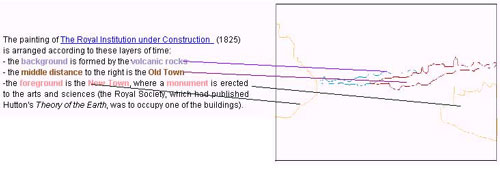| The spatial structure can be used to convey
a symbolic significance.
Example: http://homepage1.nifty.com/bobby/scotland/scot_m10.HTM
Alexander Nasmyth The Building of the Royal Institution
The spatial structure is an image of the phases
of natural and human history
- Background: prehistory
- Middle distance: the mediaeval
part of Edinburgh on the rock close to the castle
- Foregound: the New Town (18th
and early 19th c)

(extract from the CD ROM Georgian
Cities)
The painter Alexander Nasmyth (1758-1840) was descended from a
line of Edinburgh master builders; his father put up some of the
first houses in St Andrews Square.
Alexander Nasmyth believed that drawing and observation were linked;
his son James wrote in his autobiography (p.57 ff).'My father was
an enthusiast in praise of this Graphic Language ...It educates
the eye and hand and enables (the artist) to cultivate the faculty
of definite observation.'
Nasmyth retained an interest in engineering, in architectural design,
and the relating of buildings to their natural settings. His son
wrote in his Autobiography (p.42): 'My father was greatly interested
in the architectural beauty of his native city, and he was professionally
consulted by the authorities about the laying out of the streets
of the New Town ... It was his regular practice to stroll about
where building work was in progress, or new roads were being laid
out, and watch the proceedings with keen interest.'
Alexander Nasmyth frequently took walks around Edinburgh with scientists
such as Dr. Brewster , Sir James Hall, Professor Playfair and Professor
Leslie, discussing the current geological theories of the time.
James relates that he accompanied them when he left school in 1820:
'The upheaval of the rocks by volcanic heat - as seen in the Castle
Hill, the Calton Hill, and Arthur's Seat - formed in a great measure
the foundation of the picturesque beauty of the city. Those were
the days of the Huttonian controversy as to the origin of the changes
on the surface of the earth.' He explains that the timespan of the
geological changes was seen in contrast with the duration of human
history: 'The observant eye, opened by the light of science, can
see unmistakeable evidences of a condition of things which were
in action at periods so remote as, in comparison, to shrink up the
oldest of human records into events of yesterday.'
See other examples of cityscapes. |



